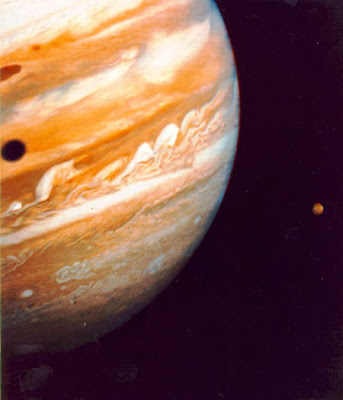ARTICLE: Astronomy 101: Jupiter
 Jupiter has been in the southern sky all night of late and will be closest to the Earth next year. This made me post this article. You know how much I love astronomy.
Jupiter has been in the southern sky all night of late and will be closest to the Earth next year. This made me post this article. You know how much I love astronomy."Today we will be learning about the Planet Jupiter. A great sight in the sky these days, Jupiter is the largest planet in the solar system and fifth from the Sun. It was named after the king of the Roman Gods.
Jupiter is approximately 484 million miles from the Sun and takes almost 12 years to complete its orbit around it. Jupiter rotates very fast so its day is only 10 hours long. Due to this fast rotation, the planet is also not entirely spherical; it has a trivial bulge around the middle since the fastest spin occurs at the equator. Because of this, Jupiter has a slight oval profile
The planet is so big that you could fit 1,300 Earths inside of it. Jupiter has a total of 49 official moons and 14 unofficial ones that are being considered.
Of those 63 moons, there are four that are the most widely known. These four, which are the largest moons orbiting Jupiter, are Io, Europa, Ganymede and Callisto.
These large moons are all interesting worlds in their own right. Astrobiologists think that Europa could even have the potential for a habitable zone. Some life forms have been found thriving near underground volcanoes and under many other extreme conditions on Earth. Europa may be very similar to those extreme locations on Earth, so life could have developed there as well.
Jupiter is a gaseous planet, its atmosphere is made up of hydrogen and helium with small traces of ammonia, rock, water and methane. It is believed to have a solid rock core as big as 18 Earth masses; this core can get as hot as 20,000 Degrees F, while the cloud-top temperature is a very cold -170 degrees F."
Jupiter is approximately 484 million miles from the Sun and takes almost 12 years to complete its orbit around it. Jupiter rotates very fast so its day is only 10 hours long. Due to this fast rotation, the planet is also not entirely spherical; it has a trivial bulge around the middle since the fastest spin occurs at the equator. Because of this, Jupiter has a slight oval profile
The planet is so big that you could fit 1,300 Earths inside of it. Jupiter has a total of 49 official moons and 14 unofficial ones that are being considered.
Of those 63 moons, there are four that are the most widely known. These four, which are the largest moons orbiting Jupiter, are Io, Europa, Ganymede and Callisto.
These large moons are all interesting worlds in their own right. Astrobiologists think that Europa could even have the potential for a habitable zone. Some life forms have been found thriving near underground volcanoes and under many other extreme conditions on Earth. Europa may be very similar to those extreme locations on Earth, so life could have developed there as well.
Jupiter is a gaseous planet, its atmosphere is made up of hydrogen and helium with small traces of ammonia, rock, water and methane. It is believed to have a solid rock core as big as 18 Earth masses; this core can get as hot as 20,000 Degrees F, while the cloud-top temperature is a very cold -170 degrees F."
Comments